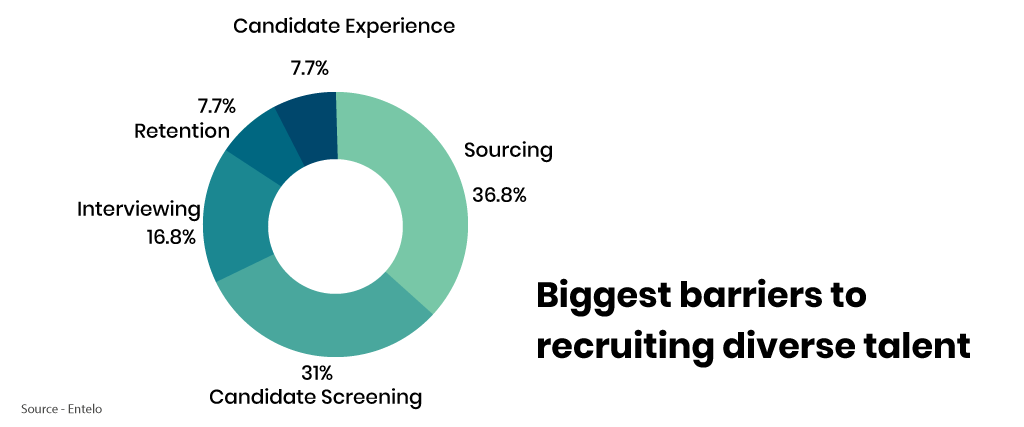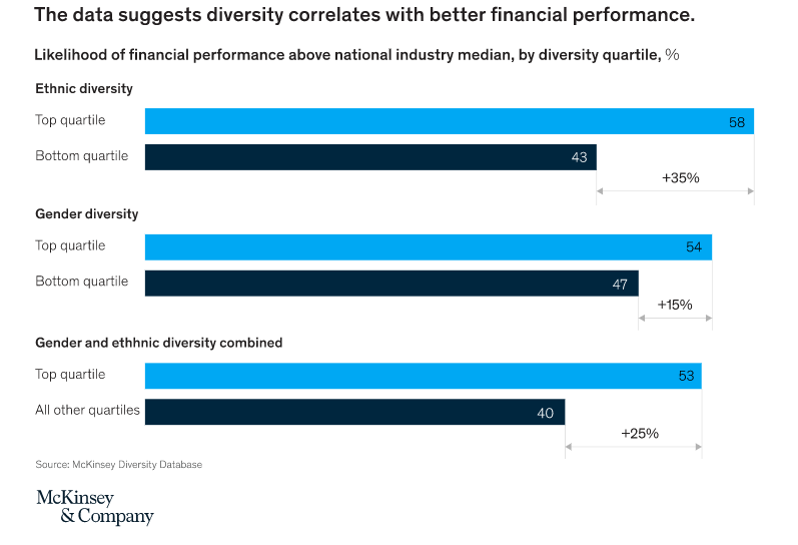Businesses stress the importance of DEI but struggle with getting the ball rolling. As the gatekeepers of the organization, recruiters play a crucial role in ensuring diverse teams. We conducted a webinar with Val Kirilova, Co-Founder and former COO at Spartoi Group,
Damon Gatison, Associate Partner at Synpulse Management Consulting, and Bradford Charles Wilkins, VP-People at Collibra, to understand the recruiter's role in ensuring diversity, equity, and inclusion. Below is an edited version of the conversation between our marketing head Sairam Krishnan and the panelists.
Before moving forward, find out how to conduct unbiased, diversified skill assessments using the best diversity recruiting tools.
SK: Let’s look at the difference between diversity, equity, and inclusion – what is it? How can organizations make them work well?
VK: Diversity is a collective group with a variety of backgrounds – different values, beliefs, cultures, and personal preferences. It’s important to make a distinction here that individuals are not diverse – groups are! Individuals may be underrepresented within groups. Within these diverse groups, inclusivity ensures that all the members within the ‘diverse’ group have access to the same resources and opportunities within the organization.
SK: What would be a good starting point for going about ensuring an equitable organization?
BW: That’s a BIG question – how do you make everything equal? The cliche is that it starts at the top. There are two key inhibitors to companies accelerating their equity and inclusivity initiatives. The first one is development – the more HR practices continue to index on artificial, biased classic requirements viz. degree, years of experience, etc. These barriers have relative to no predictive ability in terms of someone’s success or failure in the role. The second is unconscious bias. Inclusive thinking requires one to proactively think about opportunities.

DG: One thing about equity is the feeling that you’re equal. How does one create that environment where everyone is given access to the same opportunities? Cut out the favoritism – your definition of best may not be the actual best – it's still subjective. So it’s more of a cultural thing. It is important to be mindful of this as no amount of training in the world will be sufficient to remove unconscious bias unless it’s not accepted. Providing an environment of trust and equality is important. Ask questions and have difficult conversations – are you feeling included? And if not, why?
SK: What’s a recruiter’s role in diversity hiring? How should they go about devising diverse and inclusive recruitment strategies?
BW: A lot of times there is a disconnect between HR policies and driving business results. As a recruiter, it should be about asking questions about the business that help you understand the business better than the business person. I’m a believer in putting more at the top of the funnel. We’d have anywhere between 1000 applicants reviewed for just two roles! The key is to keep it as objective as possible. As a recruiter, you can help more by asking the dumb questions – what are their objectives? how would you define success for this role? With their hectic schedules, these are things that managers may not even think about because they’re moving so fast, so it’s more about challenging them vs merely taking orders.
Rather than being a transactional recruiter, once you’re thinking about adding value, turning perspectives, and challenging the manager – you really understand the role and what the capabilities need to be then the candidates naturally become more diverse and inclusive.
SK: For organizations still struggling with their D, E & I initiatives, how can teams secure buy-in from the leadership?
The business case for building a diverse organization is loud and clear. We have an HBR study, IBM had a very specific initiative to build diversity in their leadership ranks and not just the typical gender, race, etc. but rather diversity in thinking. And they saw increases across all of their productivity metrics. It really comes down to tying that business case into what the leadership wants to accomplish.
Managers have a say in who gets hired, there’s a middle-down and middle-up approach that they can take and proof of concept. The reality is that if you build a team that has a diversity of thought, especially in a large organization, you will be able to tie that or at least demonstrate a correlation. Causation might be a little bit trickier, but the correlation will be there.
DG: One of the ways to get leadership on board is to show how it affects them financially. I have been in companies, not Synpulse, that have lost business because clients have asked for their DEI metrics or DEI programs. This gives clients an idea of what the companies culture is all about.
If that client company is big on building diverse teams and an inclusive workplace and wants to work with companies that have the same beliefs, values, and opinions. Especially because as a consultancy, you have to work together with the client in order to achieve the program goal or the initiative outcome. Once they start to realize that it is necessary in order to stay competitive and win business, they’ll be more inclined to do it. I’ve seen it happen!

BW: It’s hard if you haven’t seen different perspectives before or if you’re uncomfortable with open and direct dialogue where people can openly disagree—so it’s important to foster that culture. To add another data point, Goldman Sachs said they won’t underwrite IPOs anymore unless the Board of Directors comprises 50% women. So, to add to Damon and Val’s points, this is something that’s getting more prevalent each day. There are some roles that are traditionally considered more female-oriented, such as marketing, HR, etc. but that stereotype is slowly being shattered.
Moreover, while some functions may not be considered diverse, the employees come from different backgrounds and your customers come from different backgrounds. But consider one only has males in their late 20s and early 30s handling your marketing function, it means you empathetically will appeal to that customer base more. So think about the broader opportunities in the market from the business standpoint.
Then there’s the other side – for employees – are you working for an ethical company? We can do this for business and profit reasons, but this can be done for people reasons, too. As an HR, your job should be to maximize both. The longer the employee base of the world continues working for companies that are not diverse, the longer they’ll continue to operate the same way. There are opportunities to create awareness and change from the bottom up, but, at some point, you’ll get a signal that this is not going to change. So, as employees, it’s their call to continue or pursue better cultures.
SK: How can teams track D&I success? What should be the ideal diversity recruiting KPIs and top-of-the-funnel goals?
VK: Think about your sourcing practices and your Applicant Tracking System (ATS); often, they ask candidates to provide self-identifying information, not as a mandate, though. This information can be browsed through to see what percentage of candidates in each category make it through. Then use this data to gather information—whether candidates from one part of the country are not making it through.
DG: What’s interesting is that a lot of people chose not to self-identify on those applications. I have asked individuals – why? Some people feel it’s going to be a stab against them. So, for us, we started conducting seminars to understand this and address this and make the necessary changes. And these metrics, you can’t inflate them either. Stay honest and use it in the positive.
You can access a copy of the webinar recording here.

